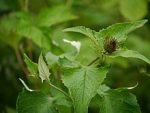 Also known as kuth, putchuk, and kosht (קשט), this herbaceous perennial is native to high elevations (8,200 to 9,800 ft) in South Asia especially India and Kashmir. It is a member of the aster family, Asteraceae, that also includes daisy, thistle, and lettuce. The plants grow up 6-9′ tall and have a rhizomatous root system and lyre-shaped leaves that are 12-16″ long and have toothed margins. The terminal flowerheads appear in summer and are 1-1.5″ cross and composed of purple florets. Th tiny dry fruit (achene) bears conspicuous grooves lengthwise. The plant has been cultivated for its root since ancient times as a medicinal herb, spice, and ingredient in perfume. Larger pieces of the root are usually cut into pieces and dried while small pieces are ground into powder and made into incense sticks. Most of the roots are shipped to China and Japan. The plant is considered endangered and trade is regulated by the government. The genus name, Saussurea, honors Horace Benedict de Saussure (1740-1799), who was a primary investigator of the geology, meteorology, and Botany of the High Alps. The specific epithet, costus, is the Latin word meaning ribbed, and refers to grooves on the fruit.
Also known as kuth, putchuk, and kosht (קשט), this herbaceous perennial is native to high elevations (8,200 to 9,800 ft) in South Asia especially India and Kashmir. It is a member of the aster family, Asteraceae, that also includes daisy, thistle, and lettuce. The plants grow up 6-9′ tall and have a rhizomatous root system and lyre-shaped leaves that are 12-16″ long and have toothed margins. The terminal flowerheads appear in summer and are 1-1.5″ cross and composed of purple florets. Th tiny dry fruit (achene) bears conspicuous grooves lengthwise. The plant has been cultivated for its root since ancient times as a medicinal herb, spice, and ingredient in perfume. Larger pieces of the root are usually cut into pieces and dried while small pieces are ground into powder and made into incense sticks. Most of the roots are shipped to China and Japan. The plant is considered endangered and trade is regulated by the government. The genus name, Saussurea, honors Horace Benedict de Saussure (1740-1799), who was a primary investigator of the geology, meteorology, and Botany of the High Alps. The specific epithet, costus, is the Latin word meaning ribbed, and refers to grooves on the fruit.
Type: Herbaceous perennial
Bloom: Flowerheads of purple florets in summer
Size: 6-9′ H x 3′ W
Light: Full sun to partial shade
Soil: Average, mediium moist, well-drained; tolerates sandy to clay soil.
Hardiness: Zones 6-9
Care: ???
Pests and Diseases: ???
Propagation: Seed, division in spring
Photo Credit: Wikipedia